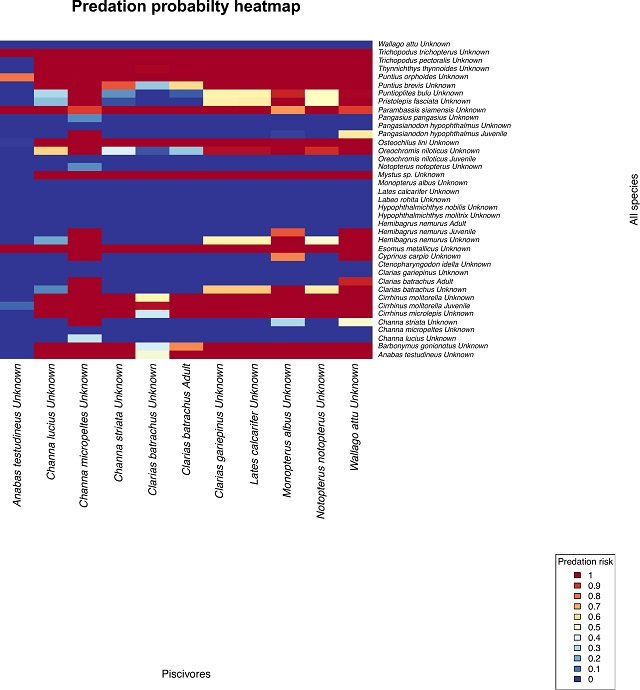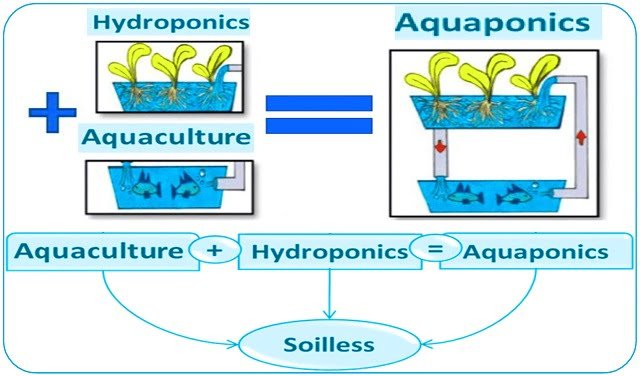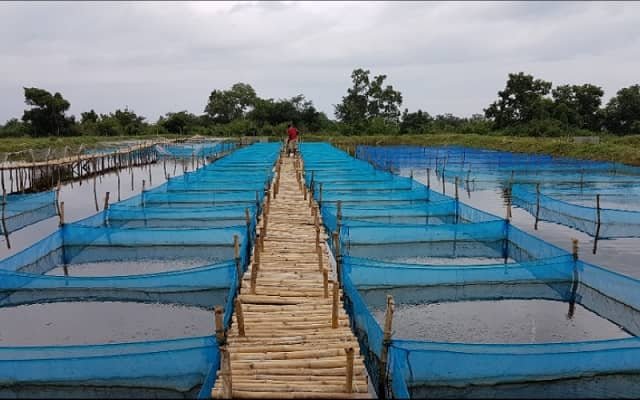
A new software tool, based on a robust scientific model, allows aquaculturists to estimate the probability of predation between species, facilitating the design of more sustainable and productive polyculture systems.
Polyculture, the practice of raising multiple species in the same system, is an ancient strategy that is gaining renewed interest for its potential to make aquaculture more sustainable. This technique can improve resource use , recycle by-products , strengthen system resilience , and even reduce operational costs. However, the success of polyculture depends on a key factor: compatibility between the species. When species do not coexist peacefully, competition, stress, and even predation can arise, negatively affecting animal welfare and production.
Predation is one of the most detrimental interactions in polyculture. Given that many high-value commercial species are piscivorous by nature (such as perch, salmonids, or snakeheads), integrating them into a polyculture system is a delicate challenge. How can one know if one species will eat another? Until now, the only way was through costly and ethically questionable empirical trials.
To address this challenge, a team of scientists from the University of Montpellier and the University of Lorraine has developed “Predish,” an innovative decision-support tool designed to estimate the risk of predation between fish based on a simple but powerful principle: the size relationship between the predator and the prey.
The polyculture dilemma: Maximizing benefits, minimizing risks
- 1 The polyculture dilemma: Maximizing benefits, minimizing risks
- 2 How does Predish work? From data to decision support
- 3 Beyond the number: How to apply Predish results
- 4 Limitations and the future of polyculture design
- 5 A step towards smarter and more sustainable aquaculture
- 6 Entradas relacionadas:
The interest in polyculture is not accidental. Its advantages over monoculture are numerous, from improving the use of feed and natural resources to making species that would not be profitable on their own economically viable. It has even been observed that it can improve fish welfare through beneficial interactions.
However, these benefits only materialize if the species are, at a minimum, compatible. This means they can coexist without detrimental interactions such as competition for space or food. Predation represents the most extreme form of incompatibility in fish farming. Therefore, accurately assessing this risk is fundamental before combining species, especially when including valuable piscivores like the pikeperch (Sander lucioperca) or snakeheads (Channa sp.).
How does Predish work? From data to decision support
Predish is not a simple guess; it is the result of rigorous scientific work. The tool is based on an allometric model that relates the size of fish (their total length) to predict the probability of a predation event.
Calibration and validation: The basis of trust
To build the model, the researchers compiled and analyzed an extensive database with 4,207 documented predation events from scientific literature, where the length of both the predator and the prey was known. This process, called calibration, allowed them to establish the parameters that define the range of prey sizes a predator can consume.
Stay Always Informed
Join our communities to instantly receive the most important news, reports, and analysis from the aquaculture industry.
Subsequently, the model was validated with a second, independent dataset of 13,707 events, which included both cases of predation and non-predation. The results demonstrated a high predictive capability:
- Sensitivity (predation prediction accuracy): 88%.
- Specificity (non-predation prediction accuracy): 96%.
- True Skill Statistic (TSS): 0.84, rated as “Excellent”.
- Area Under the Curve (AUC): 0.92, rated as “Good”.
These metrics confirm that Predish is a reliable tool for use with a wide variety of freshwater, brackish, and marine fish.
An accessible tool for the producer
The most outstanding feature of Predish is its practical application. The creators have designed it as an open-source graphical interface in the R software, making it accessible to users without advanced programming skills.
The operation is simple:
- Data input: The user enters a list of species with their scientific name and size (either a minimum and maximum range or a mean with standard deviation).
- Completing information (optional): If the user lacks size data or doesn’t know if a species is piscivorous, Predish can autocomplete this information using the TOFF (Traits OF Fish) database, which contains data for thousands of fish species.
- Calculation and results: The tool calculates the prey size range for each piscivorous species and then estimates the predation risk for each possible predator-prey pair. The result is presented as a risk matrix with values from 0 (no risk) to 1 (high likelihood of predation) and a heatmap for easy visualization.
Beyond the number: How to apply Predish results
It is crucial to understand that Predish offers a risk probability based on size, but it is not a final verdict. The authors emphasize that the user must set their own acceptable risk threshold, considering the specific context of their operation.
Some factors to consider when adjusting this threshold are:
- Feeding practices: If fish are fed ad libitum, the risk of a predator choosing to hunt a tank mate over eating pellets is lower, so a higher risk threshold could be accepted. Under starvation or restricted feeding conditions, the threshold should be much lower.
- Rearing system: In complex and extensive systems like ponds, where fish can hide, the probability of encounters decreases. In these cases, a higher risk might be tolerated (e.g., 0.5). In closed systems like RAS, with high density and little complexity, a much more conservative threshold is recommended (e.g., 0).
- Species ecology: If the predator and prey occupy different niches (e.g., one is benthic and the other is pelagic), the probability of interaction is lower, allowing for a higher risk threshold.
- Economic goals: Risk tolerance may depend on whether the higher-value species is the predator or the prey.
Limitations and the future of polyculture design
Like any tool, Predish has limitations. Its main restriction is that it is based on a definition of predation that involves swallowing the whole prey. It is not applicable for fish that partially consume prey, such as some eels.
Furthermore, the analysis is static and does not account for the differential growth of species throughout the production cycle. The authors suggest a practical solution: run the analysis twice, once with the initial sizes and again with the expected final sizes, to evaluate how the risk evolves.
A step towards smarter and more sustainable aquaculture
Predish presents itself as a valuable precautionary tool with demonstrated accuracy. It not only helps to design new polycultures more safely but can also be used to evaluate the risk of cannibalism within the same fish stock or even to analyze the impact of invasive species.
By providing aquaculturists with a scientific basis for decision-making, Predish helps reduce economic losses, improve animal welfare, and advance toward a more efficient and sustainable aquaculture. It is a clear example of how science and technology can come together to solve practical challenges in the sector.
Contact
Thomas Lecocq
University of Lorraine
L2A, Boulevard des Aiguillettes, BP 70 239, 54506 Vandœuvre-lès-Nancy, France.
Email: thomas.lecocq@univ-lorraine.fr
Reference (open access)
Lévy, S., Thomas, M., Pétronin, F., Lecomte, M., Mortillaro, J., Carval, D., & Lecocq, T. (2025). Predish: A decision support tool for estimating risk of fish predation in aquaculture systems. Aquaculture, 742833. https://doi.org/10.1016/j.aquaculture.2025.742833
Editor at the digital magazine AquaHoy. He holds a degree in Aquaculture Biology from the National University of Santa (UNS) and a Master’s degree in Science and Innovation Management from the Polytechnic University of Valencia, with postgraduate diplomas in Business Innovation and Innovation Management. He possesses extensive experience in the aquaculture and fisheries sector, having led the Fisheries Innovation Unit of the National Program for Innovation in Fisheries and Aquaculture (PNIPA). He has served as a senior consultant in technology watch, an innovation project formulator and advisor, and a lecturer at UNS. He is a member of the Peruvian College of Biologists and was recognized by the World Aquaculture Society (WAS) in 2016 for his contribution to aquaculture.




